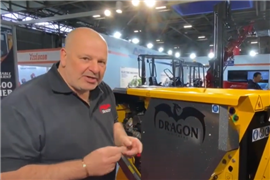Hoist expert Paula Manning explains 'which way is up'
13 February 2012
There are many different types of hoisting equipment in use in the construction business today. Three in particular can commonly be confused with each other: a construction elevator, a material hoist and a transport platform. All three are ground-based, mast -supported machines that have gates and landing doors, a floor and side walls. Each moves up and down while carrying material and/or personnel to different levels on a building. There are strict and enforced standards that call out the required elements for each machine, thus dictating how each is designed, manufactured and used in the field.
Paraphrasing from their respective ANSI codes: a construction elevator transports general site personnel and or materials to various levels; a material hoist transports material only; and finally, a transport platform moves material with a limited number of trained personnel. It is easy to see the similarities and why there may be some confusion. However, each has a purpose and usage within the industry.
The material hoist is the easiest of the three to define and the least restricted. The material hoist shall not carry people and must have a roof and fully enclosed car. These three specifications are clear and, if breached, can cause a shut down on the jobsite. It is neither limited by speed nor capacity, proximity to the building or height of the mast. A base fence enclosure is required, along with full height doors and landing gates. Material hoists are found on the majority of jobsites across the US in a multitude of variations. There are many more requirements and specifications than discussed here. The ANSI A10.5 Standard clearly details these items and is published by the American Society of Safety Engineers.
Construction elevators and transport platforms are similar in nature in that they transport men and material up and down the structure's side, and both are inherently safe when used properly. However, there are far more differences between the two than there are similarities.
Compare and contrast
The traditional high speed construction elevator is most often found on high rise commercial construction, while the transport platform is designed more for low and midrise, structurally unique architecture. The transport platform is typically more compact and can be maneuvered into areas and utilized where a traditional elevator simply cannot go.
An elevator applies a significant amount of dynamic forces and loads to the building, while a transport platform can carry the same capacity with much less interference. In fact, many transport platforms were designed to be utilized with scaffolding, even tying into an engineered conventional scaffold system. The construction elevator is a heavier machine and travels at about four and a half times greater speed than the transport platform, which is limited to 40-feet per minute. The safety factor for both machines is comparable, as is the requirement for additional safety equipment, including overload sensor and overspeed safety devices, which are not required on a material hoist.
The construction elevator car must be no more than 2 .5 inches and no less than 0.75 inches from the landing edges while the transport platform must be a minimum of 18 inches away from the structure to prevent shear hazards and pinch points. The transport platform does not require a roof, but does call for full guardrails enclosed from toe board to mid-rail. The construction elevator requires a fully enclosed car with strict designations of the steel that comprises the roof.
General worksite personnel may ride the construction elevator, which is driven by a trained and dedicated operator. Anyone on the transport platform must be authorized and trained. Additionally, the number of personnel on the platform is limited to 50 percent of the total payload.
The construction elevator must have a full height base fence enclosure with locked access to the 'pit,' and survival space under the car is required. The transport platform eliminates the need for a base fence enclosure by requiring the platform to automatically stop at 10 feet above ground level. This allows the operator to visually check for personnel or debris under the platform before continuing in the downward motion with the alarm sounding as it travels the final 10 feet.
These specifications are detailed in the ANSI A92.10 Standard for Transport Platforms, published by the Scaffold and Access Industry Association (SAIA) and the ANSI A10.4 Standard for Construction Elevators, published by ASSE. Both ANSI standards address the inherent hazards that are associated with moving personnel and materials to various levels on the jobsite, as well as governing the design and manufacture of each machine.
Suitable applications
Having briefly covered the technical differences and similarities between the three machines, the question remains: which machine for which application? Simple math will tell you that the construction elevator, with its high speeds, is built for commercial high-rise work, including new construction, renovation and building additions, where there is a need to move a large number of general site personnel to complete the project. Other applications also apply, consider: temporary industrial work, shut downs/turnarounds and the like. Material hoists are used in many configurations and load capacities, and are limited only to those places that require moving material up and down without workers on board. Transport Platforms are definitely a niche product focusing on commercial work that is low to mid-rise, historical buildings, installing/dismantling a scaffold system and even tying into scaffolding.
Understanding the correct specifications for the different machines may prove to be invaluable when estimating or planning a project. The proper equipment will increase efficiency and cost-effectiveness, and could be the difference between acquiring or losing a contract. Choosing the right machine for a specific application may not always be a clear decision, but with careful consideration of the site limitations, building configuration and the actual requirements of the trade crews, it is a decision that can positively affect the outcome of the project.






